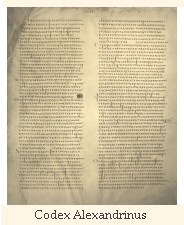Codex Alexandrinus
(A)
 Codex Alexandrinus received its name from the circumstance that its earliest known location was the Egyptian city of Alexandria. It is believed to be from the fifth century. The text is written in capitals (called uncial script), and arranged in two columns on the page. It contains the entire Greek Bible, minus Matthew 1:1 through 25:6, John 6:50 through 8:52, and 2 Corinthians 4:13 through 12:6. At the end are added some early Christian writings commonly used in teaching: the first Epistle of Clement, and the second Epistle of Clement up to 12:4.
Codex Alexandrinus received its name from the circumstance that its earliest known location was the Egyptian city of Alexandria. It is believed to be from the fifth century. The text is written in capitals (called uncial script), and arranged in two columns on the page. It contains the entire Greek Bible, minus Matthew 1:1 through 25:6, John 6:50 through 8:52, and 2 Corinthians 4:13 through 12:6. At the end are added some early Christian writings commonly used in teaching: the first Epistle of Clement, and the second Epistle of Clement up to 12:4.
The codex was sent as a gift to King James I of England (the same James who commissioned the King James version) by Cyril Lucar, who at the time was the Eastern Orthodox Bishop of Alexandria, and reached England in 1627. (See Matthew Spinka, 'Acquisition of the Codex Alexandrinus by England,' Review of Religion, xvi (1936), pp. 10-29). A collation of the New Testament was made by Alexander Huish for Walton's Polyglot (see Walton 1657) where its readings alone appeared below the Greek text, while the readings of other manuscripts were indicated in an appendix.
Bengel (see Bengel 1734) took it as a standard representative of the "African" type of text, and esteemed it above all other manuscripts known to him. Later critics have also valued it highly, but with some reservations. Schaff describes the text thus: "It presents a text which in the Gospels occupies an intermediate position between the oldest uncial and the later cursive text ... but in the rest of the New Testament it stands next to Sinaiticus and Vaticanus. In several books it agrees with the Latin Vulgate in many peculiar readings which are not attested by the older Latin; hence Dr. Hort (ii.152) infers that Jerome, in his revision, must have used to a great extent a common original with Alexandrinus." (Schaff 1891, p. 113).
The manuscript was first published in Woide 1786 (a typographical facsimile). Later editions of the manuscript are Cowper 1860, Hansell 1864, Thompson 1879, and Kenyon 1909. Full collations are in major critical editions Tischendorf 1869 and Tregelles 1857. In the Spring of 2006 the New Testament volume of Thompson 1879 was made available on the internet by The Center for the Study of New Testament Manuscripts.
See also:

 Codex Alexandrinus received its name from the circumstance that its earliest known location was the Egyptian city of Alexandria. It is believed to be from the fifth century. The text is written in capitals (called uncial script), and arranged in two columns on the page. It contains the entire Greek Bible, minus Matthew 1:1 through 25:6, John 6:50 through 8:52, and 2 Corinthians 4:13 through 12:6. At the end are added some early Christian writings commonly used in teaching: the first Epistle of Clement, and the second Epistle of Clement up to 12:4.
Codex Alexandrinus received its name from the circumstance that its earliest known location was the Egyptian city of Alexandria. It is believed to be from the fifth century. The text is written in capitals (called uncial script), and arranged in two columns on the page. It contains the entire Greek Bible, minus Matthew 1:1 through 25:6, John 6:50 through 8:52, and 2 Corinthians 4:13 through 12:6. At the end are added some early Christian writings commonly used in teaching: the first Epistle of Clement, and the second Epistle of Clement up to 12:4. 